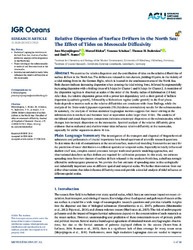Relative Dispersion of Surface Drifters in the North Sea: The Effect of Tides on Mesoscale Diffusivity
DOI: https://doi.org/10.1029/2019JC015925
Persistent URL: http://resolver.sub.uni-goettingen.de/purl?gldocs-11858/8985
Persistent URL: http://resolver.sub.uni-goettingen.de/purl?gldocs-11858/8985
Meyerjürgens, Jens; Ricker, Marcel; Schakau, Vanessa; Badewien, Thomas H.; Stanev, Emil V., 2020: Relative Dispersion of Surface Drifters in the North Sea: The Effect of Tides on Mesoscale Diffusivity. In: Journal of Geophysical Research: Oceans, Band 125, 8, DOI: 10.1029/2019JC015925.
 |
Dokument öffnen: |
We examine the relative dispersion and the contribution of tides on the relative diffusivities of surface drifters in the North Sea. The drifters are released in two clusters, yielding 43 pairs, in the vicinity of a tidal mixing front in the German Bight, which is located in the southeastern area of the North Sea. Both clusters indicate decreasing dispersion when crossing the tidal mixing front, followed by exponentially increasing dispersion with e-folding times of 0.5 days for Cluster 1 and 0.3 days for Cluster 2. A transition of the dispersion regimes is observed at scales of the order of the Rossby radius of deformation (10 km). After that, the relative dispersion grows with a power-law dependency with a short period of ballistic dispersion (quadratic growth), followed by a Richardson regime (cubic growth) in the final phase. Scale-dependent metrics such as the relative diffusivities are consistent with these findings, while the analysis of the finite-scale Lyapunov exponents (FSLEs) shows contradictory results for the submesoscales. In summary, the analysis of various statistical Lagrangian metrics suggests that tracer stirring at the submesoscales is nonlocal and becomes local at separation scales larger than 10 km. The analysis of meridional and zonal dispersion components indicates anisotropic dispersion at the submesoscales, which changes into isotropic dispersion on the mesoscales. Spectral analysis of the relative diffusivity gives evidence that semidiurnal and shallow-water tides influence relative diffusivity at the mesoscales, especially for drifter separations above 50 km.
Statistik:
ZugriffsstatistikSammlung:
- Geographie, Hydrologie [454]
This is an open access article under the terms of the Creative Commons Attribution License, which permits use, distribution and reproduction in any medium, provided the original work is properly cited.

